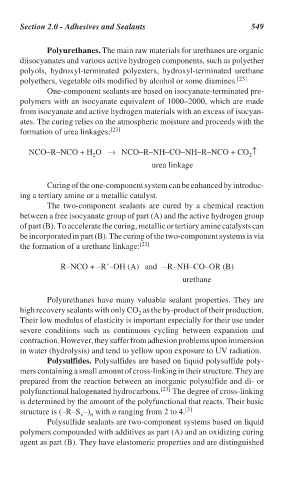Page 579 - Handbook of Thermal Analysis of Construction Materials
P. 579
Section 2.0 - Adhesives and Sealants 549
Polyurethanes. The main raw materials for urethanes are organic
diisocyanates and various active hydrogen components, such as polyether
polyols, hydroxyl-terminated polyesters, hydroxyl-terminated urethane
polyethers, vegetable oils modified by alcohol or some diamines. [23]
One-component sealants are based on isocyanate-terminated pre-
polymers with an isocyanate equivalent of 1000–2000, which are made
from isocyanate and active hydrogen materials with an excess of isocyan-
ates. The curing relies on the atmospheric moisture and proceeds with the
formation of urea linkages: [23]
NCO–R–NCO + H O → NCO–R–NH–CO–NH–R–NCO + CO ↑
2
2
urea linkage
Curing of the one-component system can be enhanced by introduc-
ing a tertiary amine or a metallic catalyst.
The two-component sealants are cured by a chemical reaction
between a free isocyanate group of part (A) and the active hydrogen group
of part (B). To accelerate the curing, metallic or tertiary amine catalysts can
be incorporated in part (B). The curing of the two-component systems is via
the formation of a urethane linkage: [23]
R–NCO + –R´–OH (A) and –R–NH–CO–OR (B)
urethane
Polyurethanes have many valuable sealant properties. They are
high recovery sealants with only CO as the by-product of their production.
2
Their low modulus of elasticity is important especially for their use under
severe conditions such as continuous cycling between expansion and
contraction. However, they suffer from adhesion problems upon immersion
in water (hydrolysis) and tend to yellow upon exposure to UV radiation.
Polysulfides. Polysulfides are based on liquid polysulfide poly-
mers containing a small amount of cross-linking in their structure. They are
prepared from the reaction between an inorganic polysulfide and di- or
polyfunctional halogenated hydrocarbons. [23] The degree of cross-linking
is determined by the amount of the polyfunctional that reacts. Their basic
structure is (–R–S –) with n ranging from 2 to 4. [3]
x
n
Polysulfide sealants are two-component systems based on liquid
polymers compounded with additives as part (A) and an oxidizing curing
agent as part (B). They have elastomeric properties and are distinguished

